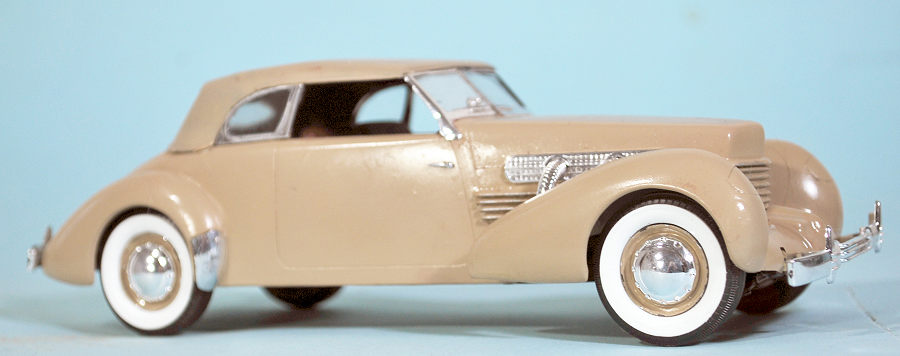
Monogram 1/25 1937 Cord 812S
| KIT #: | 0130 |
| PRICE: | $39.95 'used' |
| DECALS: | None |
| REVIEWER: | Tom Cleaver |
| NOTES: | Long OOP |

| HISTORY |
The Cord 810, and later Cord 812, was a luxury automobile produced by the Cord Automobile division of the Auburn Automobile Company in 1936 and 1937. It was the first American- designed and built front wheel drive car with independent front suspension. It was preceded by Cord's own 1929 Cord L-29, and the French 1934 Citroën Traction Avant front wheel drive cars, but the 810 / 812 was commercially less successful than these.
The Cord 810 and 812 were also the first production cars to feature hidden / pop-up headlights. Additionally, the radical new styling of its nose completely replaced the traditional radiator grille, in favor of horizontal louvers, that curved all around the sides of the nose, earning the car's styling the nickname of 'coffin nose'.
The styling of the Cord 810 was the work of designer Gordon M. Buehrig
and his team of stylists, which included young Vince Gardner and Alex Tremulis.
While the first American front-wheel-drive car with independent front
suspension, it had an archaic tube rear axle with semi-elliptic rear springs.
Power came from a 4,739 cc (289 cu in) Lycoming V8 of the same 125 hp as the
L-29. The semi-automatic four-speed transmission (three plus overdrive) extend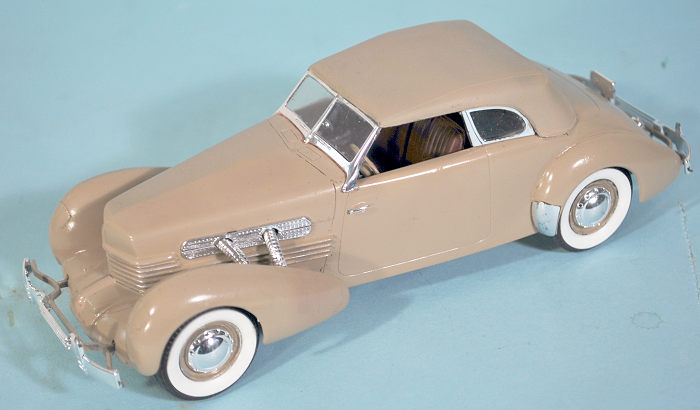 ed
in front of the engine, like on a Traction Avant. This allowed Buehrig to
eliminate the driveshaft and transmission tunnel. Accentuating its sleek,
low-slung look, it also dispensed with running boards. It had a 125 in wheelbase
(shared with several 812 body styles), and in 1936 came in four models: the
entry-level sedan at US$1,995, the Beverly sedan ($2,095), Sportsman ($2,145),
and Phaeton ($2,195). The 1937 812s had the same models, priced $2,445, $2,545,
$2,585, and $2,645. (At this time, my dentist grandfather was a member of the
upper middle class with an annual income of $6,000)
ed
in front of the engine, like on a Traction Avant. This allowed Buehrig to
eliminate the driveshaft and transmission tunnel. Accentuating its sleek,
low-slung look, it also dispensed with running boards. It had a 125 in wheelbase
(shared with several 812 body styles), and in 1936 came in four models: the
entry-level sedan at US$1,995, the Beverly sedan ($2,095), Sportsman ($2,145),
and Phaeton ($2,195). The 1937 812s had the same models, priced $2,445, $2,545,
$2,585, and $2,645. (At this time, my dentist grandfather was a member of the
upper middle class with an annual income of $6,000)
Reportedly, the 810/812 were originally conceived as Duesenberg competitors and were nearly devoid of chrome; the 810 had hidden door hinges and a rear-hinged hood, rather than the side-opening type more usual at the time, both new items. It featured pontoon fenders with hidden headlamps that were modified Stinson landing lights - E. L. Cord owned a majority of Stinson Aircraft Co. stock - that disappeared into the fenders via dashboard hand cranks. This car was the first and one of the few ever to include this feature.
It also featured a concealed lockable fuel filler door and variable-speed windshield wipers - at a time when wipers were often operated by intake vacuum, and so tended to stop when the driver stepped on the gas pedal. Its dashboard included complete instrumentation, a tachometer, and standard radio - which did not become an industry standard offering until well into the 1950s. The most famous feature was the "coffin nose" that gave the vehicle its nickname; it featured a horizontally louvered wraparound grille, a product of Buehrig's desire not to have a conventional vertical grille.
The car caused a sensation at its debut at the New York Auto Show in November 1935. The crowds were so dense that attendees stood on the bumpers of nearby cars to get a look. Cord had rushed to build the 100 cars needed to qualify for the show, but the transmission was not ready. Even so, Cord took many orders there, promising Christmas delivery. Expected production of 1,000 cars per month failed however to materialize, as the semi-automatic transmission proved more troublesome than expected. The first production cars were not ready to deliver until February, and did not reach New York City until April 1936. In all, Cord managed to sell only 1,174 of the new 810 in its first model year, as the result of mechanical troubles.
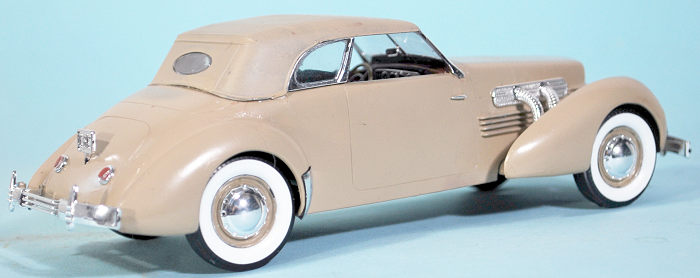 Supercharging was made available with a mechanically driven Schwitzer-Cummins
unit. Supercharged 1936 models were called 810S and 1937 models were called
812S. It was an expensive option, raising the price of the car from about $2,500
to $3,000, so only 688 units of the 812 were built with superchargers.
Supercharged models were distinguished from the normally aspirated models by the
brilliant chrome-plated external exhaust pipes mounted on each side of the hood
and grill. With supercharging, horsepower was raised to 170 hp.
Supercharging was made available with a mechanically driven Schwitzer-Cummins
unit. Supercharged 1936 models were called 810S and 1937 models were called
812S. It was an expensive option, raising the price of the car from about $2,500
to $3,000, so only 688 units of the 812 were built with superchargers.
Supercharged models were distinguished from the normally aspirated models by the
brilliant chrome-plated external exhaust pipes mounted on each side of the hood
and grill. With supercharging, horsepower was raised to 170 hp.
Early reliability problems, including slipping out of gear and vapor lock, cooled initial enthusiasm. Although most new owners loved their sleek fast cars, the dealer base shrank rapidly. Unsold left-over and in-process 1936 810 models were re-numbered and sold as 1937 812 models. Total 810/812 production was 2,972 cars, including 205 convertible cabriolets, including the one-off prototype 1938 Custom Cabriolet, before production ended in 1937.
Aside from the small production of SAMCO Cord 8/10 (1964 to 1966), the Cord 810/812 were the last American front-wheel-drive cars for almost 30 years until the debut of the Oldsmobile Toronado in 1966, followed by a heavily redesigned Cadillac Eldorado in 1967. Both these GM divisional cars paid homage to the 810/812 with hidden headlamps. The second-generation Toronado introduced a hood design that resembled the 810/812 coffin nose and horizontal cooling grille.
Los Angeles being the exotic car capitol of the world, I have actually seen a 1937 Cord 812S Phaeton Cabriolet, when I was driving over to Beverly Hills from the San Fernando Valley 30 years ago, taking the shortcut over Coldwater Canyon. Just on the Beverly Hills side of the mountains, where things get really expensive, a gate opened as I came around the curve, and out came a white Cord 812S. Yes, I was impressed and I liked being able to follow it down the curvy road to the Beverly Hills Hotel, where it turned in at the entrance.
| THE KIT |
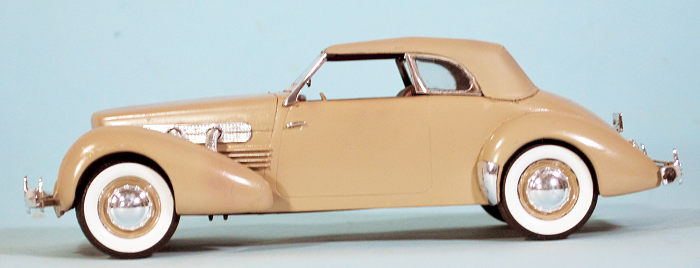 According to Scalemates, this kit came out in 1966 in a one-time
release. My LHS took in an estate sale of over 3,000 car kits, dated from
1958-89, from a collector who was in the auto industry. Among them were two of
these kits, in original shrinkwrap. I grabbed one as soon as I saw it, along
with several other rarities of old car kits. Researching the car when I got home
with the kit, I found photos of Amelia Earhart’s 812S, which was found and
restored 10 years ago. It was easy to choose to do that one!
According to Scalemates, this kit came out in 1966 in a one-time
release. My LHS took in an estate sale of over 3,000 car kits, dated from
1958-89, from a collector who was in the auto industry. Among them were two of
these kits, in original shrinkwrap. I grabbed one as soon as I saw it, along
with several other rarities of old car kits. Researching the car when I got home
with the kit, I found photos of Amelia Earhart’s 812S, which was found and
restored 10 years ago. It was easy to choose to do that one!
I love older classic cars. The other kits I grabbed were the 1963 AMT release of a 1963 Studebaker Avanti, a car I really like, having gotten to get behind the wheel of one 25 years ago that was owned by a car-collecting producer I was working for; the 1963 AMT release of the 1963 Corvette Stingray was a must-have, since I can still remember being knocked dead when I first saw one in a showroom on Geary Avenue by Union Square in San Francisco in October 1962, the day the car was publicly released; and the 1966 Monogram release of a 1/24 MG-TC was also a must-have, since I once owned one. But best of all was the 1969 Jo-Han release of a 1934 Mercedes 500K roadster. (Yes, you will see them here). All in their original shinkwrap, untouched.
| CONSTRUCTION |
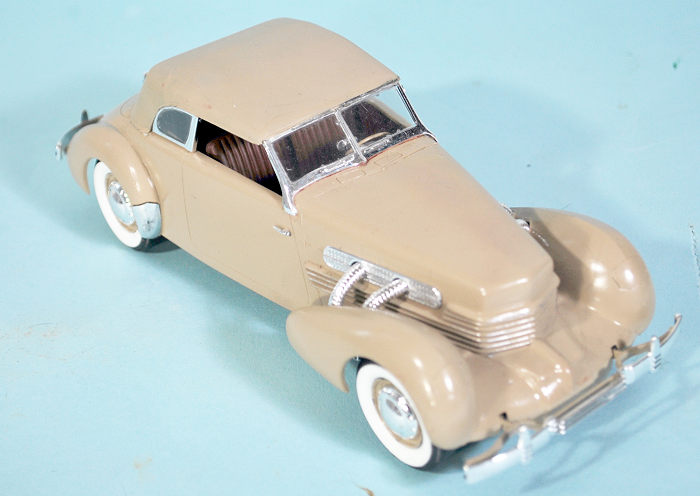 Having not built a car model in 30 years, I followed the instructions.
The kit was easy to assemble, other than I needed to fill in the gaps around the
headlight covers in the front fenders.
Having not built a car model in 30 years, I followed the instructions.
The kit was easy to assemble, other than I needed to fill in the gaps around the
headlight covers in the front fenders.
Interestingly enough, the right color for the exterior was Tamiya “Buff,” which I applied as smoothly as possible, then applied three coats of MicroScale Gloss. The correct color for the interior was close to Tamiya Hull Red. I gave that a coat of clear Satin. The convertible top was left as it was when I applied the flat Buff color.
The wheels are rubber, and include the white sidewalls as plastic inserts. They didn’t quite fit so I scraped them down until they did. The model came with an accurate engine, but I decided I would stick with a “curbside” model.
| CONCLUSIONS |
This kit was not difficult to assemble. As with most car models, it’s the paint job that is important. I think I did pretty good, knocking off 30 years of car model rust since my last one.
3 August 2023
Copyright ModelingMadness.com. All rights reserved. No reproduction in part or in whole without express permission.
Review kit courtesy of all you book buyers.
If you would like your product reviewed fairly and fairly quickly, please contact the editor or see other details in the Note to Contributors.